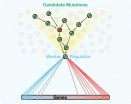(Press-News.org) A key mechanism behind diabetes may start in the brain, with early signs of the disease detectable through rising levels of molecules not previously linked to insulin signaling, according to a study led by researchers at the Icahn School of Medicine at Mount Sinai published today in the journal Cell Metabolism.
Past studies had found that levels of a key set of protein building blocks, branched-chain amino acids (BCAAs), are higher in obese and diabetic patient, and that this rise occurs many years before someone develops diabetes. Why and how BCAA breakdown may be impaired in diabetes and obesity remained unclear going into the current study.
"Our study results demonstrate for the first time that insulin signaling in the mammalian brain regulates BCAA levels by increasing BCAA breakdown in the liver," said Dr. Christoph Buettner, MD, PhD, Associate Professor of Medicine at the Icahn School of Medicine and senior author of the new study.
"This suggests that elevated plasma BCAAs are a reflection of impaired brain insulin signaling in obese and diabetic individuals."
"What's important is that rodents with impaired insulin signaling exclusively in the brain have elevated plasma BCAA levels and impaired BCAA breakdown in liver," said Dr. Andrew C. Shin, PhD, an Instructor of Medicine at the Icahn School of Medicine at Mount Sinai and the first author of this study. "Since disrupted brain insulin signaling may cause the early rise of BCAAs seen in persons who eventually develop diabetes, the insulin resistance that leads to diabetes may actually start in the brain."
"The results suggest that levels of BCAAs may prove to reflect brain insulin sensitivity," Dr. Shin added. Dr. Shin also pointed out that the team's newly discovered pathway is also found in organisms ranging from humans to rodents to worms. Mechanisms "conserved" across evolution are often of fundamental biological importance.
The initial discovery that started this line of investigation was made after proteomic and metabolomic studies of liver and plasma from rats that had been infused with insulin into the brain pointed toward a role of brain insulin signaling in BCAA catabolism. "Our study provides an example of how proteomics and metabolomics, techniques that survey proteins and metabolites allow researchers to come up with a hypothesis. They are also great discovery tools," said Dr. Buettner.
The team then went on to test the concept in a variety of animal models such as mice, rats, and round worms. They were also able to confirm in prediabetic monkeys as well as obese and diabetic humans that elevated BCAAs are associated with decreased BCAA breakdown in liver.
INFORMATION:
This study was conducted through partnerships with Pacific Northwest National Laboratory, Pennsylvania State University College of Medicine, Duke University Medical Center, University of Ulm, University Medical Center Hamburg-Eppendorf and Oregon National Primate Research Center.
The study was funded by grants from the National Institute of Diabetes and Digestive and Kidney Diseases (NIDDK) to Drs. Shin and Dr. Buettner and the American Diabetes Association to Dr. Buettner.
About the Mount Sinai Health System
The Mount Sinai Health System is an integrated health system committed to providing distinguished care, conducting transformative research, and advancing biomedical education. Structured around seven member hospital campuses and a single medical school, the Health System has an extensive ambulatory network and a range of inpatient and outpatient services—from community-based facilities to tertiary and quaternary care. The System includes approximately 6,600 primary and specialty care physicians, 12-minority-owned free-standing ambulatory surgery centers, over 45 ambulatory practices throughout the five boroughs of New York City, Westchester, and Long Island, as well as 31 affiliated community health centers. Physicians are affiliated with the Icahn School of Medicine at Mount Sinai, which is ranked among the top 20 medical schools both in National Institutes of Health funding and by U.S. News & World Report.
For more information, visit http://www.mountsinai.org, or find Mount Sinai on Facebook, Twitter and YouTube.
Set of molecules found to link insulin resistance in the brain to diabetes
Researchers at Mount Sinai have identified a key mechanism behind diabetes that may start in the brain
2014-10-09
ELSE PRESS RELEASES FROM THIS DATE:
New computational approach finds gene that drives aggressive brain cancer
2014-10-09
NEW YORK, NY (October 9, 2014)—Using an innovative algorithm that analyzes gene regulatory and signaling networks, Columbia University Medical Center (CUMC) researchers have found that loss of a gene called KLHL9 is the driving force behind the most aggressive form of glioblastoma, the most common form of brain cancer. The CUMC team demonstrated in mice transplants that these tumors can be suppressed by reintroducing KLHL9 protein, offering a possible strategy for treating this lethal disease. The study was published today in the online issue of Cell.
The team used ...
Scientists discover a 'good' fat that fights diabetes
2014-10-09
VIDEO:
Salk researchers explain how a new class of lipids may be tied to diabetes.
Click here for more information.
LA JOLLA—Scientists at the Salk Institute and Beth Israel Deaconess Medical Center (BIDMC) in Boston have discovered a new class of molecules—produced in human and mouse fat—that protects against diabetes.
The researchers found that giving this new fat, or lipid, to mice with the equivalent of type 2 diabetes lowered their elevated blood sugar, ...
Long-term treatment success using gene therapy to correct a lethal metabolic disorder
2014-10-09
New Rochelle, NY, October 9, 2014—Excessive and often lethal blood levels of bilirubin can result from mutations in a single gene that are the cause of the metabolic disease known as Crigler-Najjar syndrome type 1 (CNS1). A new gene therapy approach to correcting this metabolic error achieved significant, long-lasting reductions in bilirubin levels in a mouse model of CNS1 and is described in an Open Access article in Human Gene Therapy, a peer-reviewed journal from Mary Ann Liebert, Inc., publishers. The article is available on the Human Gene Therapy website at http://online.liebertpub.com/doi/full/10.1089/hum.2013.233. ...
Clove oil tested for weed control in organic Vidalia sweet onion
2014-10-09
TIFTON, GA – Weed control is one of the most challenging aspects of organic crop production. Most growers of certified organic crops rely heavily on proven cultural and mechanical weed control methods while limiting the use of approved herbicides. A new study of herbicides derived from clove oil tested the natural products' effectiveness in controlling weeds in Vidalia® sweet onion crops.
"Cultivation with a tine weeder and hand weeding are the primary tools currently used for weed control in organic sweet onion (Allium ceps)," explained scientist W. Carroll ...
Wild tomato species focus of antioxidant study
2014-10-09
IZMIR, TURKEY – Tomatoes are known to be rich in antioxidants such as vitamin C, lycopene, β-carotene, and phenolics. Antioxidants, substances capable of delaying or inhibiting oxidation processes caused by free radicals, are of interest to consumers for their health-related contributions, and to plant breeders for their ability to provide plants with natural resistance to biotic and abiotic stresses. While tomato domestication and breeding programs have typically focused on traits such as fruit weight, color, shape, and disease resistance, scientists are now ...
Study examines effect of antibiotic susceptibility for patients with bloodstream infection
2014-10-09
In an analysis of more than 8,000 episodes of Staphylococcus aureus bloodstream infections, there were no significant differences in the risk of death when comparing patients exhibiting less susceptibility to the antibiotic vancomycin to patients with more vancomycin susceptible strains of S. aureus, according to a study published in JAMA. The study is being released early online to coincide with the IDWeek 2014 meeting.
Staphylococcus aureus is among the most common causes of health care-associated infection throughout the world. It causes a wide range of infections, ...
Hospitalized children benefit from antibiotic stewardship programs
2014-10-09
PHILADELPHIA – Hospitalized children go home sooner and are less likely to be readmitted when the hospital has an antibiotic stewardship program that's dedicated to controlling antibiotic prescriptions and treatment, according to a study being presented at IDWeek 2014™. The study is the first to show the benefits of such programs on children's health.
Antibiotic stewardship programs are increasingly being used to manage how and when antibiotics are being prescribed in hospitals and other health care facilities across the country. Often led by epidemiologists or ...
Chemists uncover new role of a key base in organic synthesis
2014-10-09
An international team of chemists has discovered a new piece to the puzzle of how a powerful base used in organic synthesis, cesium carbonate, plays a pivotal role during a catalytic reaction.
The research, published by the Journal of the American Chemical Society, was led by Jamal Musaev, a theoretical chemist at Emory University, and Ken Itami, an experimental chemist from Nagoya University in Japan. Sun Yat-Sen University in Guangzhou, China, also contributed to the findings.
Many organic chemistry reactions are acid/base reactions, involving the exchange of positively ...
NASA eyes Tropical Cyclone Hudhud as Warnings posted for East-Central India
2014-10-09
NASA's Aqua satellite flew over Tropical Cyclone Hudhud on Oct. 9 and took a picture of the storm that showed it was still somewhat elongated, but more organized than the previous day. Another NASA satellite provided the hint of a developing eye. Warnings for winds, rain and surf are already in effect for the northern Andhra Pradesh coast and south Odisha coastline of eastern India as Hudhud approaches.
Tropical Cyclone Hudhud formed on Oct. 8 and began moving from east to west across the Bay of Bengal, Northern Indian Ocean.
On Oct. 9 at 07:45 UTC (3:45 a.m. EDT), ...
Discovery of new subatomic particle sheds light on fundamental force of nature
2014-10-09
The discovery of a new particle will "transform our understanding" of the fundamental force of nature that binds the nuclei of atoms, researchers argue.
Led by scientists from the University of Warwick, the discovery of the new particle will help provide greater understanding of the strong interaction, the fundamental force of nature found within the protons of an atom's nucleus.
Named Ds3*(2860)ˉ, the particle, a new type of meson, was discovered by analysing data collected with the LHCb detector at CERN's Large Hadron Collider (LHC) .
The new particle ...
LAST 30 PRESS RELEASES:
Injectable breast ‘implant’ offers alternative to traditional surgeries
Neuroscientists devise formulas to measure multilingualism
New prostate cancer trial seeks to reduce toxicity without sacrificing efficacy
Geometry shapes life
A CRISPR screen reveals many previously unrecognized genes required for brain development and a new neurodevelopmental disorder
Hot flush treatment has anti-breast cancer activity, study finds
Securing AI systems against growing cybersecurity threats
Longest observation of an active solar region
Why nail-biting, procrastination and other self-sabotaging behaviors are rooted in survival instincts
Regional variations in mechanical properties of porcine leptomeninges
Artificial empathy in therapy and healthcare: advancements in interpersonal interaction technologies
Why some brains switch gears more efficiently than others
UVA’s Jundong Li wins ICDM’S 2025 Tao Li Award for data mining, machine learning
UVA’s low-power, high-performance computer power player Mircea Stan earns National Academy of Inventors fellowship
Not playing by the rules: USU researcher explores filamentous algae dynamics in rivers
Do our body clocks influence our risk of dementia?
Anthropologists offer new evidence of bipedalism in long-debated fossil discovery
Safer receipt paper from wood
Dosage-sensitive genes suggest no whole-genome duplications in ancestral angiosperm
First ancient human herpesvirus genomes document their deep history with humans
Why Some Bacteria Survive Antibiotics and How to Stop Them - New study reveals that bacteria can survive antibiotic treatment through two fundamentally different “shutdown modes”
UCLA study links scar healing to dangerous placenta condition
CHANGE-seq-BE finds off-target changes in the genome from base editors
The Journal of Nuclear Medicine Ahead-of-Print Tip Sheet: January 2, 2026
Delayed or absent first dose of measles, mumps, and rubella vaccination
Trends in US preterm birth rates by household income and race and ethnicity
Study identifies potential biomarker linked to progression and brain inflammation in multiple sclerosis
Many mothers in Norway do not show up for postnatal check-ups
Researchers want to find out why quick clay is so unstable
Superradiant spins show teamwork at the quantum scale
[Press-News.org] Set of molecules found to link insulin resistance in the brain to diabetesResearchers at Mount Sinai have identified a key mechanism behind diabetes that may start in the brain




